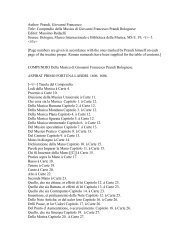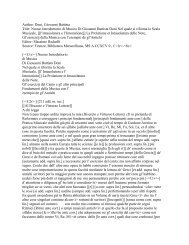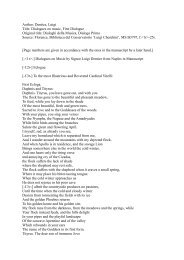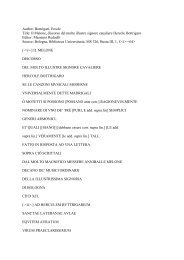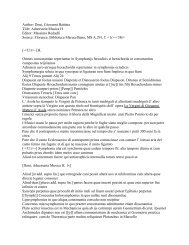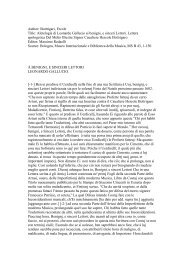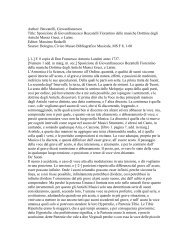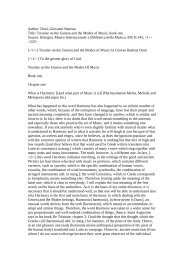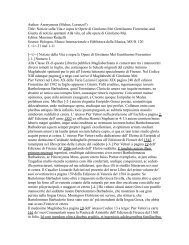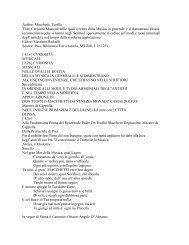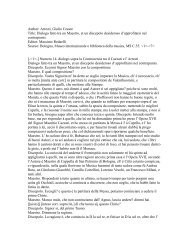Manuscripts of Italian Music Theory in Translation
Manuscripts of Italian Music Theory in Translation
Manuscripts of Italian Music Theory in Translation
You also want an ePaper? Increase the reach of your titles
YUMPU automatically turns print PDFs into web optimized ePapers that Google loves.
I wanted to describe everyth<strong>in</strong>g, I would be too prolix, and also what is put <strong>in</strong>to practiceaga<strong>in</strong>st its nature cannot sort a good effect, s<strong>in</strong>ce it is removed from its aim.It is true that very <strong>of</strong>ten, as I said elsewhere, <strong>in</strong> order to enact with the <strong>Music</strong> the mean<strong>in</strong>g<strong>of</strong> the words, it is not convenient or appropriate for the Composer to move to the closestconsonance, for <strong>in</strong>stance, from the major sixth to the octave, or from the m<strong>in</strong>or sixth tothe fifth, or from the m<strong>in</strong>or third to the Unison, or <strong>in</strong> other similar cases. In fact, he isjustified <strong>in</strong> this because <strong>of</strong> the effect <strong>of</strong> cheerfulness or sadness that the Composer ispursu<strong>in</strong>g. Nor would he have committed an error deserv<strong>in</strong>g a punishment or which wouldjustify him be<strong>in</strong>g detested and numbered among those who only follow their discretion.Tenth. The Composer must know which ones are the fuller Consonants and which onesare the most attractive, and he must know the difference between two imperfectConsonances and their <strong>in</strong>dividual quality [signum]Eleventh. He must notice and consider carefully that a Composition can be said to beperfect when one can hear those consonances which produce a variety <strong>of</strong> sounds <strong>in</strong> theirextremes <strong>in</strong> every comb<strong>in</strong>ation <strong>of</strong> notes or <strong>in</strong>tervals, whatever we want to call them, bothtowards the low register as towards the high register. [signum]Twelfth. It is necessary to understand and know how several perfect or imperfectconsonances conta<strong>in</strong>ed with<strong>in</strong> the same form can be employed one after the other <strong>in</strong>sequence, and on which terms this is allowed.[[f.19v-] et [-f.20r-] desunt][-f.20v-] this pr<strong>of</strong>ession, as he has done with his writ<strong>in</strong>gs, and I have not fallen short <strong>of</strong>follow<strong>in</strong>g every written <strong>in</strong>struction <strong>of</strong> his as much as I could. Now, if it seems that I wantto argue aga<strong>in</strong>st his op<strong>in</strong>ion with this discourse, let me do this like a pupil argu<strong>in</strong>gtowards his Teacher <strong>in</strong> order to learn better. Therefore, with that reverence that isexpected <strong>of</strong> me, I will adduce some reasons to the contrary, and, if you like them, youwill hold that op<strong>in</strong>ion which you like the most. I do not know if you have ever read hisInstitutioni Harmoniche at Chapter five <strong>of</strong> the third part, or if you have ever heard peoplesay<strong>in</strong>g that he is absolutely conv<strong>in</strong>ced that the Diatessaron is a perfect <strong>in</strong>terval.Pupil: I have been told this many, many times, but I do not the reason why this is.Sometimes, when I wanted to employ it by itself <strong>in</strong> a Counterpo<strong>in</strong>t, like I used theDiapente or the Diapason without preparation as a perfect consonance, I did f<strong>in</strong>d that itwas dissonant, nor could it stand but with the support <strong>of</strong> another perfect or imperfect onewith its resolution on the major or m<strong>in</strong>or third, which everybody observes.Teacher: First <strong>of</strong> all, it is necessary that you should know the reasons that Zarl<strong>in</strong>oproduces to prove that it is a perfect consonance. If you do not know them, you cannotunderstand this discussion.He tells <strong>in</strong> the ma<strong>in</strong> that Ptolemy, Boethius, Macrobius, the philosopher Gaudentius,Vitruvius, Censor<strong>in</strong>us and others whom I omit to be brief, ma<strong>in</strong>ta<strong>in</strong> that the Diatessaron isa perfect consonance, for some reasons which I do not believe logical. He providesevidence for his op<strong>in</strong>ion <strong>in</strong> this way and he says: “Those <strong>in</strong>tervals, which one hears be<strong>in</strong>gperfectly consonant when they are sounded by themselves, cannot be dissonant <strong>in</strong> any



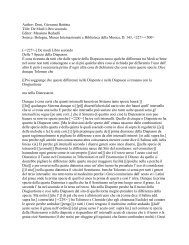
![Doni, Giovanni Battista Title: Trattato Dei Tuoni o [[Harmonie de]]](https://img.yumpu.com/45461005/1/190x245/doni-giovanni-battista-title-trattato-dei-tuoni-o-harmonie-de.jpg?quality=85)
